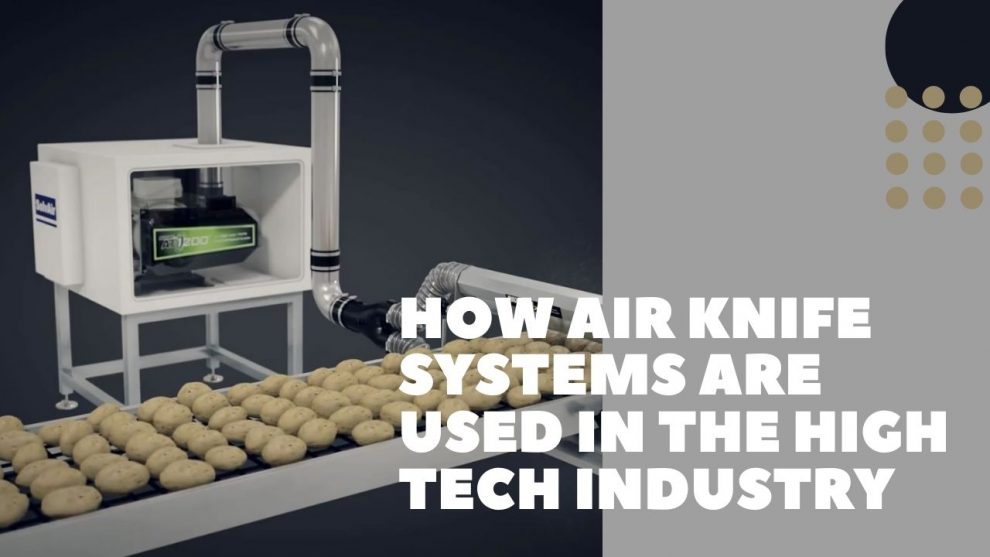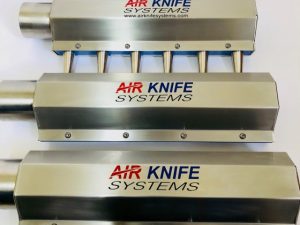The manufacturing industry has long used air to remove moisture from parts freshly cut or milled from raw goods. In the high tech industry, this allows the creation of highly detailed, often tiny parts with little risk of corrosion once the moisture is removed.
Industries Traditionally Connected With Air Knives
Air knives have a long-standing history with the food industry, particularly in the drying and cooling of produce. In addition, air knives are used to dry metal that’s recently been cut or formed, to cool recently formed hot plastics, and more recently, to remove moisture from high tech components, such as freshly printed circuit boards.
Finally, air knives can be used in the packaging process. Hot plastic packaging materials, formed into smaller packages via sealing tools, can be quickly cooled and any static removed before the individual packages are loaded into shipping containers.
Construction Basics
An air knife blower forces air through slots at prescribed forces and times. The volume of air moved and extracted can be customized to make sure that parts are not damaged by the force of the air or knocked off the conveyor belt. It should be noted that the movement of the belt over the rollers can lead to static buildup. To prevent static damage, the air can be treated with electrical currents as it is directed through the slot.
Drying Power
Metal parts that are treated with air knives are generally wet from the cutting or milling process. Allowing cutting liquids to stand on the metal can lead to oxidation, which can weaken the material and may alter the shape of the part. Accurate treatment through an air tool after cutting will remove moisture and protect the material. Air volume is critical when setting up air knives as drying tools; the more severely compressed the air, the cooler it will be as it expands, and the greater the risk of condensation as the metal cools. Air knives can be constructed to produce lower and lower levels of air flow to allow complete drying without excess cooling.
Controlled Liquid Removal
Air knives can also be used to control liquid removal. For example, many cutting liquids include an oxidation inhibitor that will cling to the metal and provide protection after the water has been removed. The liquids to be managed and used as a protective coating may require a higher air speed to dislodge; properly aligned and controlled air knives will leave this protective coating in place as a protectant.
Heat Reduction
Cutting and forming metal and forming plastic are both prone to creating extreme heat. Air knives of varying speeds and intensities can be used to cool recently created products while making no changes to the intended shape. The control of extracted air is extremely important in these cases; plastic is formed in a vacuum, so the curing temperature must be exceeded to change raw plastic into a formed good. Additional air pressure and movement will function to cool, not alter the part, as the air knives do their work.
Debris Removal
Any metal cutting process will create a great deal of debris or shavings. Even with the inclusion of flocculants in the cutting liquid, shards of metal can cling to a newly cut part. As air knives do the work of removing the correct percentage of liquid from the recently cut parts, some of this debris may have traveled with the part and been caught up in the air extraction stream. Additionally, many flocculants are ionized to encourage the attraction of metals in the liquid to fall out of suspension and clump. Shavings that fail to clump will be dried along with the part, and may become airborne in the stream. Reducing static charge from both the part and the shards is critical during the drying process.
Static Control
Modern air knife technology allows manufacturers to remove more than water. One of the big risks to fine electronic components comes from static build-up. Current air technology includes an ionizing bar that kills static as air is directed at the component. This ionizing bar inclusion means that employees can handle the parts at the end of the drying process with no risk of static shock and that the parts also will suffer no shock damage.
Rapidly moving air is inherently static building; one of the fastest ways to destroy any electronic is to vacuum it or hit it with canned air that’s not protected against static. It’s also important to note that compressed air will cool down any surface it touches, as compressed air is moving from high to low pressure and will naturally cool as it expands. Cold things will eventually warm up, but moisture condensation is always a risk. Air knives, properly treated for ionization as air is released over the object, will dry and cool it without increasing the risk of static or moisture damage.
Sealant Completion
If your recently cut parts need to be coated in a sealant or even paint, time under an air knife can be used to finish the sealing process. The products on an air belt can be sped up or slowed down, and the volume of air can be timed, increased or reduced. Air knives offer a great deal of variety in terms of the processes that can be performed under them.
Post-Packaging Uses
It’s important to note that air knives can be of use in the post-packaging process. Individual packaging in sealed plastic is used on objects from muffins to circuit boards, and sealing plastic creates heat. To reduce this heat quickly without risking moisture or static build-up can be easily done with air knives. In fact, many sealing processes occur in conjunction with air knives, leaving the final cut and separation of packaging at a manual knife site away from the heat of sealing tools.
The technology of air knives has long aided the manufacturing process to cool, dry and decontaminate freshly cut or formed objects. With proper maintenance and an eye toward air flow and static reduction, this technology can be used on metals, plastics, detailed technology, and food for years to come.











